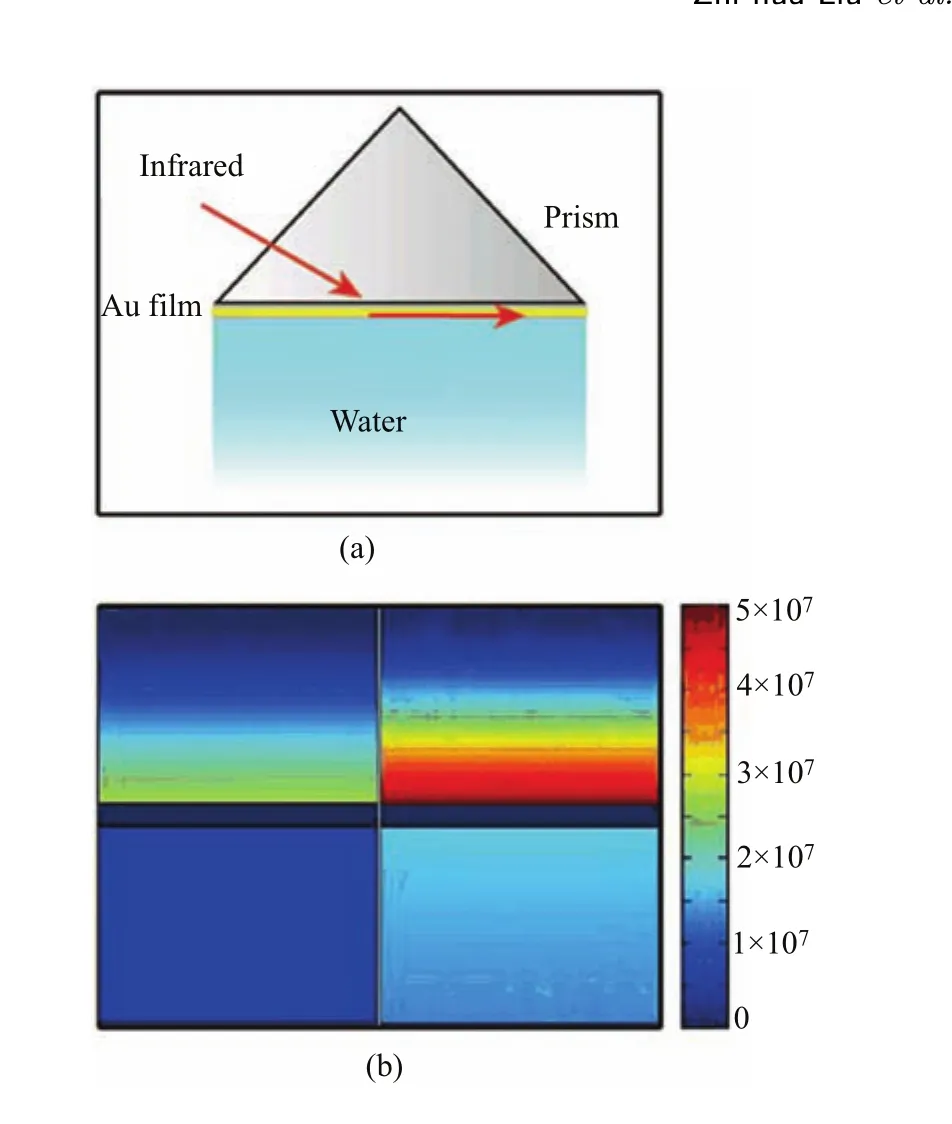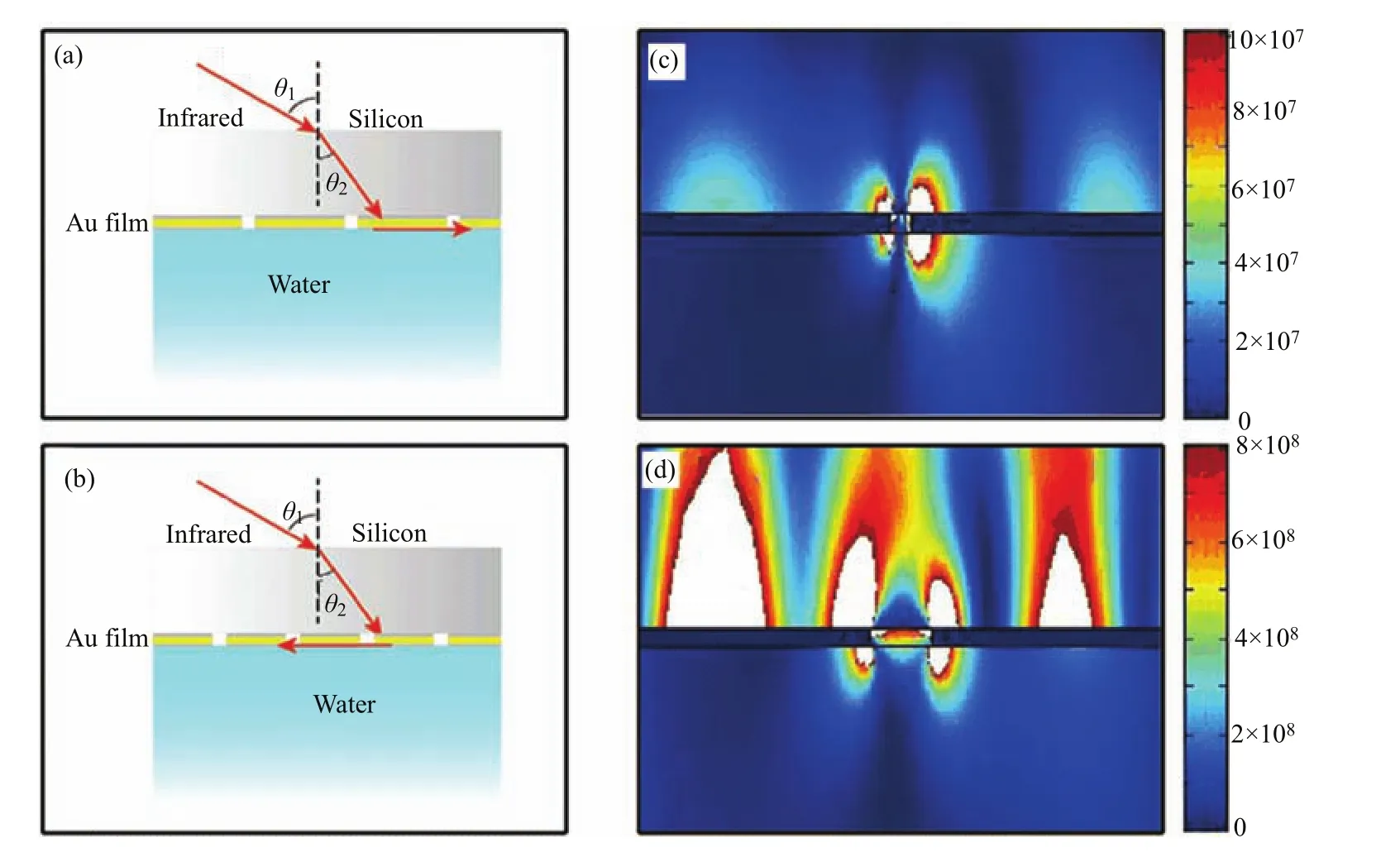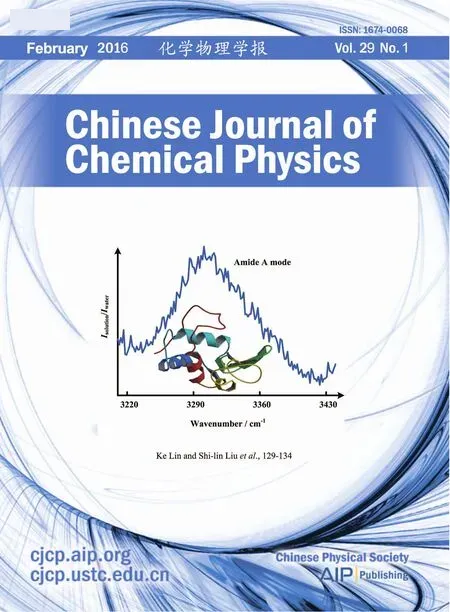ARTICLE Plasmonic Field Enhancement for Vibration Spectroscopy at Metal/Water Interfaces†
Zhi-hua Liu,Qian Xu,Wei-tao Liu∗State Key Laboratory of Surface Physics,Key Laboratory of Micro and Nano Photonic Structures (MOE),Collaborative Innovation Center of Advanced Microstructures and Department of Physics,Fudan University,Shanghai 200433,China(Dated:Received on December 17,2015;Accepted on February 2,2016)
ARTICLE Plasmonic Field Enhancement for Vibration Spectroscopy at Metal/Water Interfaces†
Zhi-hua Liu,Qian Xu,Wei-tao Liu∗
State Key Laboratory of Surface Physics,Key Laboratory of Micro and Nano Photonic Structures (MOE),Collaborative Innovation Center of Advanced Microstructures and Department of Physics,Fudan University,Shanghai 200433,China
(Dated:Received on December 17,2015;Accepted on February 2,2016)
Electrochemical(EC)reactions play vital roles in many disciplines,and its molecular-level understanding is highly desired,in particular under reactions.The vibration spectroscopy is a powerful in situ technique for chemical analysis,yet its application to EC reactions is hindered by the strong attenuation of infrared(IR)light in both electrodes and electrolytes. Here we demonstrate that by incorporating appropriate sub-wavelength plasmonic structures at the metal electrode,the IR fi eld at the EC interface can be greatly enhanced via the excitation of surface plasmon.This scheme facilitates in situ vibrational spectroscopic studies,especially using the surface-speci fi c sum-frequency generation technique.
Key words:Metal water interfaces,Surface plasmon excitation,Extraordinary optical transmission
†Part of the special issue for“the Chinese Chemical Society’s 14th National Chemical Dynamics Symposium”.
∗Author to whom correspondence should be addressed.E-mail: wtliu@fudan.edu.cn
I.INTRODUCTION
Electrochemistry is among the most important disciplines in modern science and industry,playing key roles in numerous processes including electrosynthesis,electrolysis,and many others[1].However,our understanding on electrochemical(EC)reactions regards mostly energetics,which is based on conventional I-V analytical tools[2].The in situ identi fi cation of unknown species as intermediates,products,and characterization of real-time molecular bonding-geometry,orientation,and conformation,remains a scienti fi c challenge [3].Such molecular-level information must be obtained with species-focused analytical tools,for example,the vibration spectroscopy[4,5].The sum-frequency vibrational spectroscopy(SFVS)can be regarded as a surface-speci fi c version of vibration spectroscopy,which has enabled molecular-level studies of various interfacial systems,in particular liquid interfaces,over the past two decades[6].Still,its application on this topic was limited,because most EC interfaces are not accessible in the IR range of interest,as both electrodes and electrolytes are often strong infrared(IR)absorbers.To overcome this,we exploited the surface plasmon(SP) resonance at the gold electrode,and achieved in situ vibration spectra of a thiol self-assembled monolayer under redox processes,providing real-time information of the reactions[7].
II.METHOD
Nonetheless,the fi eld enhancement by SP resonance decays rapidly when the absorption of the electrolyte grows.In particular,water is one of the most important and widely used electrolytes[8],yet it also has very intense and broad infrared absorption bands in OH vibration regimes.It turns out that the fi eld enhancement by conventional SP excitation schemes on smooth metal fi lms(such as the Kretschmann con fi guration used in our previous study[7])is not strong enough for probing vibration spectra of water itself.In this study,we propose the integration of sub-wavelength nano-gratings on metal electrodes to boost up the fi eld enhancement.In analogue to the e ff ect of extraordinary optical transmission(EOT)e ff ect[9],the guided fi eld through metallic trenches couples to the SP and compensates for its loss. With optimal parameters,the IR fi eld can be enhanced appreciably even on water absorption peaks.Such plasmonic structures are readily employed to SFVS,and are also generally applicable to other IR spectroscopy techniques of EC interfaces.
To analyze the electric fi eld at designated interfaces,we performed numerical simulations with the radio frequency module using the fi nite element method with Comsol Multiphysics 3.5[10].Floquet periodicity boundary condition is used for oblique incidence[11].
III.RESULTS AND DISCUSSION
A.Field enhancement by the Kretschmann con fi guration The SP excitation on smooth surfaces is usually via Otto[12]and Kretschmann[13]con fi gurations.Theschematics of the latter is illustrated in Fig.1(a).The SP at the metal and underneath dielectric interface can be excited when its energy and momentum both match with that of the incident light.The resonant angle of the incident light is found to be[14]:

Given the prism material,metal,and dielectric being silicon,gold,and water,respectively(related dielectric constants can be found in Refs.[15,16]),the resonant angle is found to be 24.3◦at 3300 cm−1,near the IR absorption peak of water.The spatial distributions of electric fi eld near a 20 nm-thick gold fi lm on(right panel) and o ff(left panel)resonance are shown in Fig.1(b).It is seen that at the gold/water interface,the eletric fi eld is enhanced upon the SP resonance but only for about 2 times due to the strong absorption of water.In contrast, the SP enhancement of the IR fi eld at~2900 cm−1can be more than an order.Since the fi eld strength in the latter case was essential for a reasonable signal-noiseratio(SNR)in SFVS experiments,the above scheme is not enough for probing water spectra in this frequency range(around 3300 cm−1).
B.Field enhancement with sub-wavelength nano-grating
To boost up the fi eld enhancement,we utilize plasmonic-structured gold fi lms instead of smooth ones (c)and(d),for a 20 nm-thick gold fi lm and 50 nm slit .width.Clearly pg(−)leads to a much greater electric .fi eld strength at the gold/water interface(note the different scales)compared to not only the grating structure with pg(+),but the smooth fi lm as well.
To understand this e ff ect,we fi rst note that the re-,duced fi eld enhancement at 3300 cm−1is due to the strong absorption of water.Hence a simple picture for the additional enhancement by the grating structure is that through each slit,the guided fi eld can couple to the SP wave and compensate for its loss.The coupling is possible as the guided fi eld at the slit has an evanescent component,as in the case for EOT[17].Compared ,to pg(+),pg(−)yields a larger number of slits per unit length,therefore a better compensation for the loss.ac-.cording to Eq.(2),pg(−)has the samllest possible value at m=1,which thus is the optimal period for our structure.
There are two more desirable features of the fi eld distribution in Fig.2(d)for SFVS studies of EC interfaces. First,the strongest fi eld does not locate inside the slit, but at the nearby metal/water interface that we aim at. This is in contrast with plasmonic-structures designed for enhanced far- fi eld transmission[18],which has the fi eld concentrated inside the slit.Second,with the SP wave propagating oppositely to the incident IR wave,it is easier to achieve a large angular separation between the sum-frequency beam and upconverting visible(or NIR)beam re fl ected from the electrode[19],which fa-The schematic of the structure is shown in Fig.2(a) Here,instead of prism,we consider a planar silicon wafer that supports the gold fi lm.In this case,the momentum mismatch between the SP wave and freespace IR wave is compensated by the periodic grating structure engraved on gold[14].When SP is excited there is the relation that:

Here θ0is the same angle as in Eq.(1),m is a positive interger,λIRis the wavelength of the IR light in silicon pgis the periodicity of the grating,and θ2is the refractive angle of the IR beam in the silicon wafer(Fig.2(a)) For experimental purpose,the IR incident angle is preferentially the Brewster angle to minimize the θ1being the Brewster angle from the air to silicon,and θ2is thus determined.The periodicity(pg)for exciting the mth-order SP wave can then be obtained.
Still,for a given m,there are two possible pgvalues corresponding the+ad−signs in Eq.(2).With the +(−)sign,the SP wave propagates along the same (opposite)direction with the parallel component of the incident IR wave,as shown in Fig.2(a)(Fig.2(b)).With m=1,and at 3300 cm−1,we found pg(+)=6.45µm and pg(−)=1.27µm,respectively.The fi eld distributions for the two di ff erent periodicities are plotted in Fig.2cilitates the detection and increases the SNR.

FIG.1(a)The Kretschmann-Raether con fi guration for SP excitation using a coupling prism.(b)Spatial distributions of electric fi eld with resonance on(incident angle=24.3◦, right panel)and o ff(incident angle=16.2◦,left panel)at 3300 cm−1,the thickness of the gold fi lm is 20 nm.

FIG.2(a)and(b)Schematics of the SP excitation at the interface between water and gold nano-grating deposited on a fl at silicon wafer.(c)and(d)Spatial distributions of electric fi eld for(a)and(b).The white parts in(c)and(d)represent the most intense part of the fi eld.

FIG.3(a)−(c)Integrated interfacial fi eld intensity along the gold/water interface with di ff erent parameters at 3300 cm−1, (d)−(f)3600 cm−1.K,W and T refer to the IR frequency,slit width,and gold fi lm thickness,respectively.
C.Optimal parameters for the nano-grating
Besides the periodicity,the interfacial fi eld strength is also dependent on the slit width and fi lm thickness. We calculated the integrated fi eld intensity along the gold/water boundary with di ff erent parameters to obtain the optimal structure.Figure 3(a)−(c)((d)−(f)) show the fi eld intensity at various periodicity, fi lm thickness,and slit width,respectively,for 3300 cm−1 (3600 cm−1).In contrast to the smooth fi lm,the intensity actually increases with the fi lm thickness between 20 and 100 nm(Fig.3(b)and(e)).This is anotherdesirable feature of the structure,as thicker fi lms are more robust under both the laser irradiation and electrical cycling.Overall,at both frequencies,a slit width of around 150 nm,and a fi lm thickness of 50−100 nm are appropriate.

FIG.4 The integrated IR fi eld intensity at the gold/water interface(normalized to the period)versus the IR frequency. The gold fi lm thickness is 100 nm,and the slit width is 150 nm.
However,due to the limited bandwidth of the SP resonance,a single periodicity cannot cover the entire water absorption band.This is better illustrated in Fig.4, showing the evolution of resonant frequencies with the periodicity.Therefore,it is preferential to combine two di ff erent periods,for example,1.24 and 1.27µm to achieve an enhancement for the entire OH stretch vibration band.
IV.CONCLUSION
We utilized a sub-wavelength nano-grating structure to boost up the IR fi eld at the gold/water interface for SFVS studies on EC reactions.With appropriate structural parameters,our simulations show such a scheme can greatly enhance the interfacial IR fi eld compared to the smooth fi lm,enabling the detection of interfacial water spectra using SFVS.At 3300 and 3600 cm−1,the optimal grating periods are 1.24 and 1.27µm,respectively,and the optimal fi lm thickness and slit width are at 50−100 and 150 nm.
V.ACKNOWLEDGMENTS
This work was supported by the National Natural Science Foundation of China(No.11374065,No.11290161, and No.11104033),the National Basic Research Program of China,and the Ministry of Education of China (No.2014CB921600 and No.2012CB921400).
[1]C.H.Hamann,A.Hamnett,and W.Vielstich,Electrochemistry,2nd Edn,Weinheim:Wiley-VCH,Preface, XIII(2007).
[2]S.Nicholson and I.Shain,Anal.Chem.36,706(1964).
[3]W.Kaim and A.Klein,Spectroelectrochemistry,1st Edn,Cambridge:Royal Society of Chemistry,Preface, V(2007).
[4]W.T.Liu,L.N.Zhang,and Y.R.Shen,Chem.Phys. Lett.412,206(2005).
[5]W.T.Liu and Y.R.Shen,Phys.Rev.Lett.101,016101 (2008).
[6]W.T.Liu,L.N.Zhang,and Y.R.Shen,J.Chem. Phys.125,144711(2006).
[7]W.T.Liu and Y.R.Shen,Proc.Natl.Acad.Sci.USA 111,1293(2014).
[8]E.M.Stuve,Chem.Phys.Lett.519,1(2012).
[9]T.W.Ebbesen,H.J.Lezec,H.F.Ghaemi,T.Thio, and P.A.Wol ff,Nature 391,667(1998).
[10]COMSOL Inc.COMSOL Multiphysics 3.5,Burlington, USA,(2008).
[11]M.Z.Li,Z.H.An,L.Zhou,F.L.Mao,and H.L. Wang,Chin.Phys.Lett.28,075206(2011).
[12]A.Otto,Z.Phys.216,398(1968).
[13]E.Kretschmann,Z.Phys.241,313(1971).
[14]H.Raether,Surface Plasmons on Smooth and Rough Surfaces and on Gratings,Hamburg:Springer-Verla,4 (1986).
[15]E.D.Palik,Handbook of Optical Constants of Solids, New York:Academic,286(1998).
[16]E.D.Palik,Handbook of Optical Constants of Solids II, New York:Academic,1075(1998).
[17]L.Martin-Moreno,F.J.Garcia-Vidal,H.J.Lezec,K. M.Pellerin,T.Thio,J.B.Pendry,and T.W.Ebbesen, Phys.Rev.Lett.86,1114(2001).
[18]D.B.Shao and S.C.Chen,Nano Lett.6,2279(2006).
[19]C.Zhang,J.Jasensky,and Z.Chen,Anal.Chem.87, 8157(2015).
 CHINESE JOURNAL OF CHEMICAL PHYSICS2016年1期
CHINESE JOURNAL OF CHEMICAL PHYSICS2016年1期
- CHINESE JOURNAL OF CHEMICAL PHYSICS的其它文章
- ARTICLE E ffi cient Separation of Ar and Kr from Environmental Samples for Trace Radioactive Noble Gas Detection†
- REVIEW Polarization Dependent Time-Resolved Infrared Spectroscopy and Its Applications†
- ARTICLE Reactions of Group V Metal Atoms with Hydrogen Sul fi de:Argon Matrix Infrared Spectra and Theoretical Calculations†
- ARTICLE Structural Dynamics of Phenyl Azide in Light-Absorbing Excited States: Resonance Raman and Quantum Mechanical Calculation Study†
- ARTICLE Structural and Infrared Spectroscopic Study on Solvation of Acetylene by Protonated Water Molecules†
- ARTICLE Excited-State Proton Transfer and Decay in Hydrogen-Bonded Oxazole System:MS-CASPT2//CASSCF Study†
